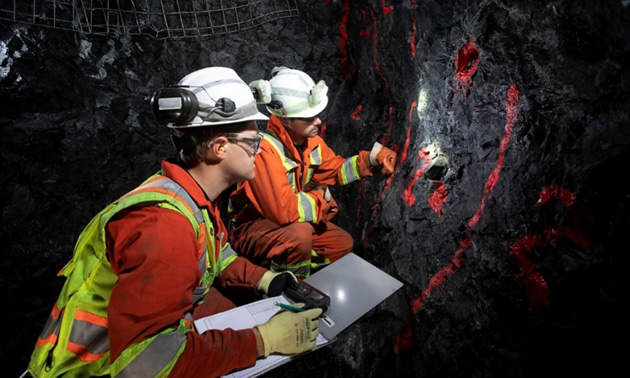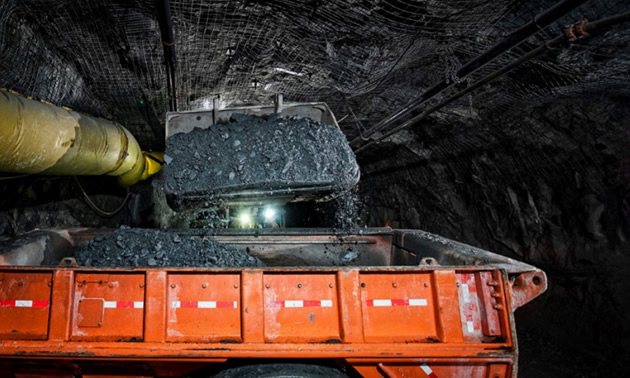Pure Gold Test Mining returns an estimated 56% more gold than predicted from resource model

Underground testing at the Madsen Gold Project. — Photo courtesy Pure Gold Mining Inc.
VANCOUVER, B.C. – Pure Gold Mining Inc. (PGM – TSX-V) (“Pure Gold” or the “Company”) is pleased to report that test mining at Madsen has now completed with a total of 7,096 tonnes of mineralized material extracted from three distinct stoping areas. Test mining has been extremely successful in highlighting the strong visual nature of the mineralization, demonstrating excellent ground conditions, and confirming the geologic model that underpins the mine plan for the ongoing definitive feasibility study. Results have exceeded expectations, with tonnes, grade and mining width greater than predicted from the resource model. Overall, an average grade of 10.2 g/t gold was returned from 1,555 muck samples collected during mining of the bulk sample. The average grade of 10.2 g/t gold is a capped, diluted mined grade, which comprises all muck samples from 70 rounds of freshly blasted rock, each of which averaged above a cut-off of 4.0 g/t gold.
Key points
- At a 4.0 g/t gold cut-off, the bulk sample estimate includes 46% more tonnes, 8% higher gold grade and an estimated 56% more ounces of gold than predicted from the resource model blocks;
- Overall mining width of 5.3 metres, exceeding the predicted width of the mineralized structures by 53%.
- In the two planned stoping areas, mined tonnes were within 1% of the predicted tonnes from the resource model, with an estimate of 14% more ounces than expected due to a higher than predicted average diluted grade of 10.9 g/t gold at a 4.0 g/t gold cut-off;
- Underground drilling conducted during test mining defined a third stoping area, resulting in the mining of an estimated 440 additional ounces of gold from 1,575 tonnes at a grade of 8.7 g/t gold;
Further underground drill results continue to identity opportunities for extensions to mining. New drilling highlights include:
- 20.1 g/t gold over 6.0 metres from drill hole PGB-0131, including 38.6 g/t gold over 2.0 metres;
- 47.6 g/t gold over 6.0 metres from drill hole PGB-0134;
- 30.3 g/t gold over 2.0 metres and 133.0 g/t gold over 1.0 metre from drill hole PGB-0140;
- 15.2 g/t gold over 2.9 metres from drill hole PGB-0152.
Darin Labrenz, President and CEO of Pure Gold commented, “Our test mining program has been a resounding success, checking each of the boxes we laid out when we initiated the program earlier this year. From the first round blasted in the ramp to the completion of the program in November, our team has demonstrated it can visually identify, and easily follow gold mineralization underground providing a strong validation of our geologic model. Overall, test mining returned an estimated 56% more gold than predicted, with limited dilution achieved through average widths that exceed five metres. With test mining now complete, delivering a strong validation of both geologic model and resource, we look forward to finalizing our definitive feasibility study as the next step to building a modern, scalable mining operation at Madsen.”
Pure Gold Completes 7,100 tonne Bulk Sample
In late May, the Company initiated a bulk sample program designed to partially test two proposed stopes from the McVeigh zone. Test mining was completed in excellent ground conditions with approximately 242 metres of new lateral drive development completed near the base of the two proposed stopes at a depth of approximately 160 metres below surface, and the completion of 24 metres of vertical development in two raises. An important outcome of the test mining program was the recognition of the strong visual nature of the mineralization, including abundant visible gold, distinctive veining and alteration typical of the Red Lake mining district, allowing the team to efficiently mine higher grade mineralization with limited dilution.
Grade reconciliation reported is defined by muck samples collected in a regular pattern with five individual muck samples, averaging 2 kg each, taken from every second scoop bucket, resulting in one muck sample for every three tonnes of mining. Typically, each blast had an average of about 25 muck samples collected, and all the samples from each round were averaged to confirm a particular rounds grade exceeded the 4.0 g/t gold cut-off. The average mining width over a total of 70 mining faces is 5.3 metres, with a maximum of twelve metres in true width, resulting in lower mining dilution and suggesting an opportunity locally for increased utilization of efficient bulk mining methods.
Reconciliation between mined material and the mineral resource from the two proposed stopes was exceptionally strong, with actual tonnes equal to the predicted total at a 4.0 g/t gold cut-off, and actual grade exceeding predicted by 15%. When compared to initial, diluted stope designs for the two stoping areas, test mining achieved a 20% higher grade and 11% more ounces than predicted. Overall, test mining returned 56% more gold than predicted from the resource due to the mining of parallel structures in a third stoping area, discovered by close spaced drilling conducted from underground. The successful mining of these parallel structures highlights an opportunity for future growth and additional mining from delineation drilling from underground. Mineralized material from the bulk sample has been stockpiled in a secure underground location at Madsen and is expected to provide future feed for mill commissioning.
Phil Smerchanski, Vice President, Exploration of Pure Gold added, “The positive results of this mining highlight the disciplined and conservative approach that Pure Gold has applied to resource estimation. Our resource work is well supported by comparison to this test program and also the extensive previous mining records at Madsen. It has been invigorating to get to work mapping and mining this gold mineralized rock that we have focused so much study on over the last 4 years. Our whole team is very excited about the growth possibilities at Madsen.”

Ore transfer - Madsen Underground Test Mining. — Photo courtesy Pure Gold Mining Inc.
Underground Drilling
In concert with an extensive sampling program to characterize the mineralization during test mining, the drift walls were tested each round with a core drill to identify potential for additional mineralization. EW-sized (2.5cm) core drill holes were drilled with a Bazooka air drill with holes averaging 13 metres in length. This underground drill program has been highly successful, identifying additional mineralized structures outside of, but in close proximity to new mine development. Three of these tested structures have been partly mined along with the current bulk sample. Many of the structures remain open and demonstrate continuity providing opportunities to be incorporated into a future mine plan following a positive production decision.
About Madsen
The Madsen Gold Project has a current indicated resource of 1,744,000 ounces gold at 8.7 g/t gold (in 6.2 million tonnes) and an inferred resource of 296,000 ounces gold at 7.9 g/t gold (in 1.2 million tonnes), the Project benefits from extensive infrastructure including a mill and tailings facility, paved highway access, and access to power, water and experienced labour. A feasibility study is underway with results expected in January 2019 and the Madsen Gold Project is firmly on the path to becoming Ontario’s next gold mine.
About Pure Gold
Our mandate is pure and simple. To dream big. To colour outside the lines. To use smart science and creativity to unlock the Madsen Gold Project in Red Lake, Ontario. And become Canada’s next iconic gold company. Additional information about the Company and its activities may be found on the Company’s website at www.puregoldmining.ca and under the Company’s profile at www.sedar.com.
Forward looking statements apply.




